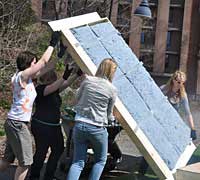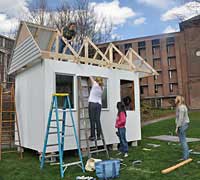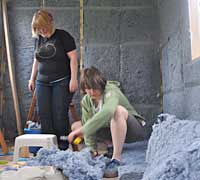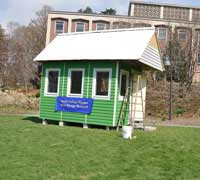It's
Warm Inside but Nobody's Home
Knock all you want, but nobody will answer. No one lives
in this house.
Installation of a solar house: Watch a video

Students haul insulated
walls onto Burton Lawn in early April. |

Before long, the house
begins to take shape. |

Inside, students install
layers of denim insulation. |

The completed house, warmed
by the sun, gathers data daily. |
The quaint structure sitting on Burton Lawn attractively
painted with green clapboards and white trim is designed
to yield information about how to make domiciles more energy
efficient. Although from the exterior it looks inviting,
the inside is an unfurnished functional shell not meant for
occupation.
The house was built and
installed by students in Physics 100, Solar Energy and
Sustainability, taught by Nat Fortune, associate professor
of physics. “One of my goals with
this house is to provide my students with the capability
to improve the performance of an existing home, or recommend
efficiencies to others,” said Fortune.
In addition to learning
about “green” building
techniques, Fortune’s students learned practical skills
as they assisted in the construction of the house in the
McConnell Hall basement Center for Design and Fabrication,
wielding power tools, finishing walls, and installing windows
and insulation.
But the focus of the project
is the house’s performance
in absorbing and containing heat. As it absorbs the sun’s
warmth, the “solar house” is equipped with sensors
for monitoring its interior temperature. The class, with
Fortune’s guidance, is testing the efficiency of the
house with different systems of insulation in order to determine
where heat loss occurs.
Students first fitted the house with foam board around its
walls. A layer of thick-padded insulation made from recycled
denim blue jeans followed. (In practice, the recycled denim
insulation is more effective than the traditional fiberglass
insulation, said Fortune.)
Finally, exterior walls and concrete floor tiles were added
and daily records of the interior temperature fluctuations
began, comparing the performance of the insulation and thermal
mass with expectations. Fortune plans to maintain a log of
energy statistics through the end of the spring semester,
when the class will disassemble the house and return it to
storage.
So far, the house has held heat well, Fortune reports, remaining
at a comfortable 60 to 70 degrees Fahrenheit even as outdoor
temperatures have varied between 80 degrees and freezing.
“I want my students to see this house as it improves
its performance throughout the stages of insulation,” he
said. Based on what they discover, Fortune’s students
will be able to assess the heating and insulation in their
own homes, and bring their knowledge with them to future
domiciles.
“This is very applicable knowledge,” said Miranda
Mickiewicz ’10. “We’re learning how much
energy it takes to heat water for a shower, for example,
and how to heat effectively with solar energy.”
For their final project, students designed a solar heating
system for a house from their hometown, in which they determined
the proper size of solar panels and thermal water systems.
“This class also shows us the benefits of small measures,
like switching the setting on your laptop to sleep mode,
replacing shower heads, and what size heating systems work
best,” said Ayla Schlosser ’09. “The knowledge
we get in this class is geared towards the individual, so
that each of us can take it with us and apply it in the future.”
Meanwhile, the little house on Burton Lawn, heated for longer
periods by the sun each day, continues gathering data that
will lend insight to solar energy systems.
Though the house will
come down in May, Fortune plans to use it again for future
classes, he said. “I’d
love to have a house outside year-round—to be able
to test during winter months, too.”
|























